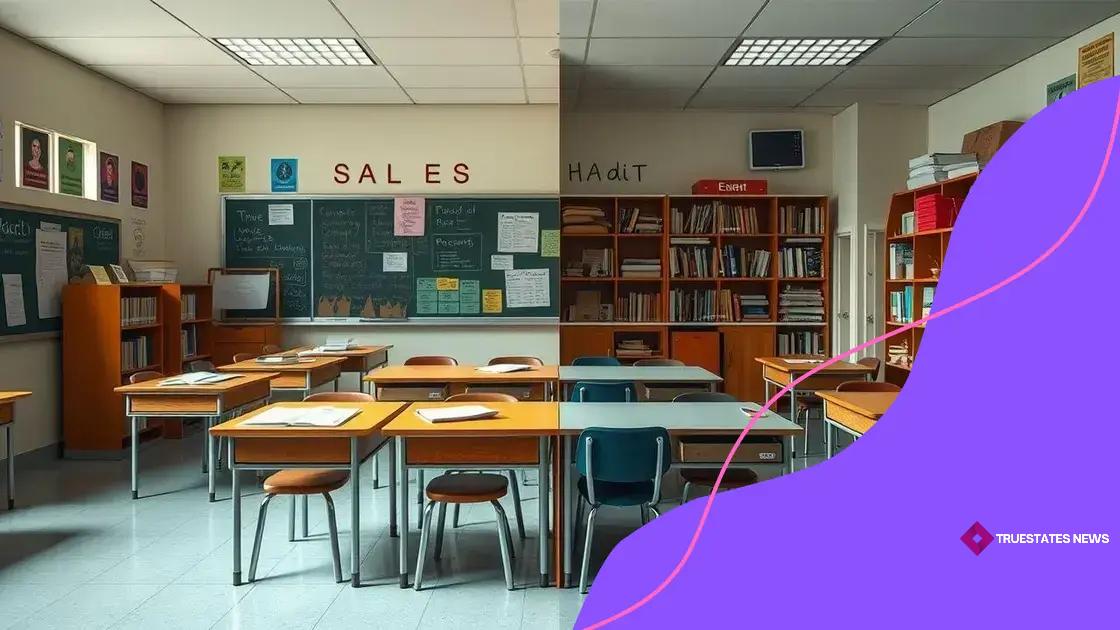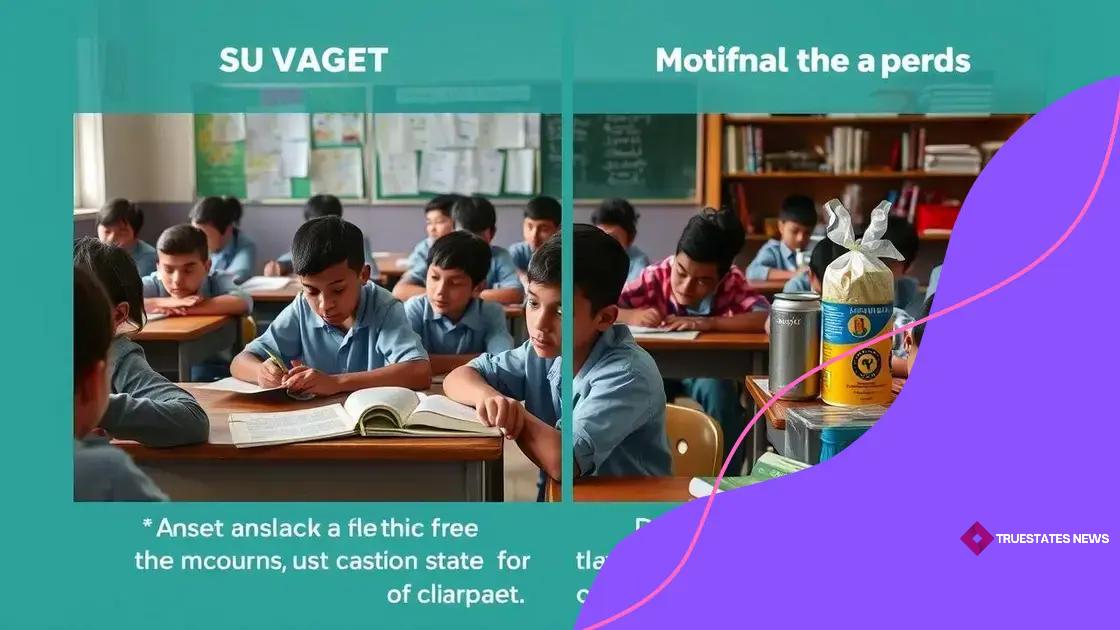School funding disparity: a silent crisis

School funding disparity refers to the unequal distribution of financial resources among schools, primarily driven by reliance on local property taxes, which affects student performance and opportunities across different communities.
School funding disparity affects many students across the country, leading to uneven access to resources and opportunities. Have you ever wondered how this impacts learning environments? Let’s dive into this pressing issue and explore its effects.
Understanding school funding disparity
Understanding the school funding disparity is essential for anyone concerned about education. It affects students differently depending on where they live. Have you noticed the differences in schools across various neighborhoods? This issue goes beyond mere budget numbers; it influences the future of countless children.
What is school funding disparity?
School funding disparity arises from uneven distribution of financial resources among schools. Factors like local property taxes and state funding formulas significantly shape how much money each school receives. The result? Schools in affluent areas often have access to better facilities, more experienced teachers, and advanced learning materials.
Key Factors Contributing to Disparities:
- Property Taxes: Wealthier neighborhoods contribute more through property taxes.
- State Funding: Different states allocate funds based on varying criteria.
- Federal Aid: Limited federal support often fails to bridge the gaps.
- Community Resources: Schools in higher-income areas usually have better support from local businesses.
These factors create a cycle where disadvantaged schools struggle to overcome their limitations. For instance, schools with less funding tend to face overcrowded classrooms and outdated technology. This situation makes learning less effective and can harm students’ futures.
Moreover, when children do not receive the same quality of education, the long-term effects ripple through communities. Inequities in education can lead to larger societal issues, including economic disparities and increased crime rates. It’s vital to recognize how funding inequities impact every child’s opportunity in life.
The Importance of Addressing Disparities:
Addressing these funding disparities is crucial. It is about fairness and ensuring that every child has equal opportunities. Everyone deserves access to quality education, no matter their zip code. Advocacy and awareness in communities can play a significant role in changing these outcomes.
Causes of unequal funding in education
The causes of unequal funding in education are complex and multifaceted. Understanding these factors is crucial for addressing the disparities that affect many students. One of the main reasons for inequality lies in the common practice of funding schools through local property taxes. This often means that schools in wealthier neighborhoods receive more funding, leading to substantial differences in resources.
Key Factors Leading to Unequal Funding:
- Property Tax System: Schools are funded largely based on local property values. Higher property taxes lead to better-funded schools.
- State Funding Formulas: Each state has different criteria for allocating education funds. This varies widely, affecting school budgets.
- Economic Disparities: Communities with greater wealth can contribute more to their schools, while low-income areas struggle.
- Political Decisions: Policies regarding education funding can greatly influence how resources are distributed among schools.
Moreover, these factors create a cycle of disadvantage. Schools that lack funding often cannot provide the same quality of education as their better-funded counterparts. For instance, they may have fewer teachers or insufficient materials. The effects of this disparity are felt at all levels, from elementary schools to high schools.
Additionally, schools in underfunded areas might face challenges like outdated technology and inadequate facilities. These issues hinder teachers’ ability to deliver effective lessons and may dampen student motivation. As a result, students in poorer districts often experience larger class sizes and less individualized attention, impacting their learning outcomes.
The Impact of Social Factors:
Social factors also contribute to unequal funding. Families in wealthier areas are often able to raise additional funds through local fundraising efforts. This philanthropy can create a significant gap in resources. Moreover, parents with more educational awareness and advocacy skills are better equipped to demand improvements in their schools.
Effects on student performance

The effects of school funding disparity on student performance are profound and far-reaching. When schools lack adequate funding, students often face challenges that impact their education and future. For instance, overcrowded classrooms and limited access to resources can hinder the learning experience.
Impact on Academic Achievement:
Students in underfunded schools tend to perform lower on standardized tests compared to their peers in well-funded areas. This gap in performance can lead to fewer opportunities for higher education and career advancement. Factors such as less experienced teachers and limited advanced coursework options further contribute to this achievement gap.
Key Factors Affecting Student Performance:
- Teacher Quality: Lower funding often leads to hiring less experienced teachers who may lack the necessary training.
- Resources: Insufficient materials like books, technology, and extracurricular programs limit student engagement.
- Class Size: Larger class sizes in low-funded schools mean less individual attention for each student.
- School Environment: Poor facilities can affect student motivation and mental well-being.
Additionally, emotional and social support is often lacking in schools with lower funding. Students may struggle with stress and anxiety, which can further impact their ability to concentrate and learn effectively. The combination of these factors creates a cycle where students in disadvantaged schools find it harder to succeed academically.
The long-term consequences of this can be severe. Students who do not perform well in school are less likely to graduate and often have limited job prospects. This, in turn, perpetuates the cycle of poverty and inequality. Families that can’t invest in education may find themselves trapped in a system that offers little hope for improvement.
Addressing the Performance Gap:
Recognizing the effects of funding disparities on performance is the first step toward change. Awareness and action can lead to advocacy for more equitable funding solutions, ensuring every student has access to quality education, regardless of their background.
Community responses to funding issues
Community responses to funding issues in education play a crucial role in addressing disparities. Many communities come together to advocate for fair funding and to support their local schools. These grassroots efforts are essential in driving change and securing better resources for students.
Ways Communities Are Involved:
Communities often organize events and campaigns to raise awareness about school funding disparities. Local fundraisers, rallies, and informational meetings mobilize families and residents to collaborate on solutions. When community members unite, they can effectively voice their concerns and push for improvements in their schools.
Key Strategies Used by Communities:
- Fundraising Events: Schools often hold bake sales, charity runs, and auctions to gather additional resources.
- Advocacy: Parents and local leaders work with school boards and legislators to advocate for better funding policies.
- Partnerships: Collaborations with local businesses can provide necessary support and resources for schools.
- Awareness Campaigns: Social media and community outreach programs inform others about the impacts of funding disparities.
The involvement of community members, especially parents, is vital. They can voice their needs and work collectively to create change that benefits all students. With a more united front, communities can hold local governments accountable and demand equitable funding.
Moreover, successful initiatives often inspire other communities to take similar actions. As places share their experiences, they can learn from one another, creating a network of support and advocacy. Highlighting these efforts can also attract media attention, making the issue of funding disparities more visible and garnering broader support.
Examples of Successful Community Initiatives:
Some communities have successfully campaigned for increased funding by showcasing the stark differences in educational resources. These campaigns illustrate how funding disparities impact students directly. Through these efforts, communities not only inform the public but also inspire others to react and take action.
Possible solutions and reforms
Exploring possible solutions and reforms for school funding disparity is vital for creating a more equitable education system. Communities, educators, and policymakers are taking steps to address these inequalities and ensure every student has access to the resources they need.
Funding Reforms:
One potential reform is changing how schools are funded. Shifting away from heavy reliance on local property taxes can help balance funding more evenly across districts. Some states have started to implement more equitable funding formulas that take into account the needs of students, not just local tax revenues.
Key Solutions for Addressing Funding Issues:
- State-Level Initiatives: States can create policies aimed at redistributing funds more fairly to underserved schools.
- Increased Federal Support: Advocating for higher federal funding can help fill gaps without relying solely on local taxes.
- Community Engagement: Involving parents and local organizations can lead to enhanced fundraising efforts and support for schools.
- Partnerships with Nonprofits: Collaborations can provide additional resources and programs that benefit students.
Another important aspect of reform is strengthening community advocacy. When communities work together to address funding disparities, they can put pressure on local and state governments to prioritize education. This can lead to changes in policies and funding paradigms that support schools in need.
Moreover, educational programs that emphasize creativity and critical thinking can also be developed to better prepare students for the future. Investing in teacher training and professional development ensures that educators have the tools and resources to support their students effectively.
Utilizing Technology:
Integrating technology into the classroom can also aid in bridging funding gaps. Providing access to digital learning tools and resources can enhance the educational experience, especially in underfunded schools. Virtual collaborations and resources from tech companies can create new learning opportunities.
In conclusion, addressing school funding disparity is essential for ensuring that every student receives a quality education. By understanding the causes and impacts of this issue, communities can take action to promote equitable funding. Engaging in advocacy, supporting local schools, and working together can lead to meaningful reforms. With collaborative efforts, we can bridge the funding gaps and create opportunities for all students to thrive.
FAQ – Frequently Asked Questions about School Funding Disparity
What causes school funding disparity?
School funding disparity is primarily caused by the reliance on local property taxes, unequal state funding formulas, and economic disparities among communities.
How does funding disparity affect student performance?
Funding disparity can lead to lower academic achievement, larger class sizes, and fewer resources, which ultimately impact students’ educational outcomes.
What can communities do to address funding issues?
Communities can organize fundraisers, advocate for policy changes, and form partnerships with local businesses to support their schools.
Are there solutions to improve school funding?
Yes, possible solutions include changing funding formulas, increasing federal support, and engaging in community advocacy to promote equitable funding.
